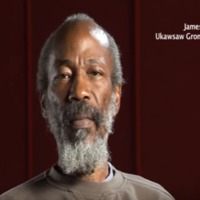
The Longest Journey: from Slavery to Abolition
The Longest Journey: From Slavery to Abolition was held at Epping Forest District Museum in October 2007. The exhibition also toured venues in the region, including the Cambridge and County Folk Museum. The exhibition examined clues in the collections of Essex museums and the Essex Record Office exploring the history of the slave trade and the abolition movement in Essex. A set of ‘Essex Links' panels revealed the Essex people and places involved, including the story of Anne Knight, Chelmsford resident and abolitionist. As part of the project, a film was commissioned for Black History Month 2007: ‘The Story of James Albert Ukawsaw Gronniosaw, an African Prince' is based on the autobiography published in 1774 by James Albert, a freed slave. Captured into slavery as a child in present-day Nigeria, once freed he travelled to England where he lived and worked in Colchester. The film features actor Shango Baku and was produced by Harvest Films and commissioned by Epping Forest District Museum, Museums in Essex Committee and Renaissance in the Regions.
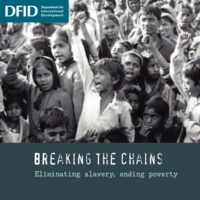
Breaking the Chains: Eliminating slavery, ending poverty
The official publication to mark the bicentenary from the Department for International Development, with a particular focus on the links between poverty and forms of modern slavery around the world.
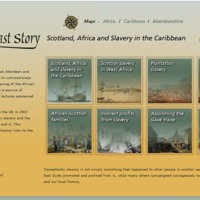
A North East Story: Scotland, Africa and Slavery in the Caribbean
This online exhibition and learning resource linking the history of transatlantic slavery to North East Scotland was organised by an Aberdeen and Aberdeenshire Bicentenary Committee, including representatives from Aberdeenshire Council, Aberdeen City Council, the University of Aberdeen, the Robert Gordon University and the African and African-Caribbean communities. It followed on from a service of commemoration and a series of public lectures sponsored by the Committee in 2007. The exhibition logo is inspired by the mythical Sankofa bird, a cultural symbol of the Akan-speaking peoples of Ghana in West Africa. Featured here are a number of resources available to download from the North East Story website.
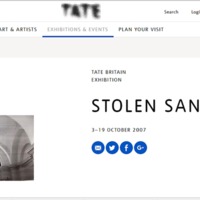
Stolen Sanity
In 2007 the artist Faisal Abdu'Allah was commissioned by Tate Britain to work collaboratively with a group of young people from Park High School in Harrow and St George's Roman Catholic School in Westminster to explore ideas related to the commemoration of the 1807 Abolition Act. The group engaged with creative research and artistic processes to produce narratives capturing their personal viewpoints on the themes of freedom of expression, liberty, revolution and slavery. The project Stolen Sanity resulted in a series of large scale photographic portraits that were displayed in the main galleries of Tate Britain. The project integrated the factual historic time line of Tate Britain's display, 1807: Blake, Slavery and the Radical Mind, with fictional personal reflections through audio and visual art.
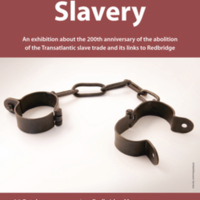
Redbridge and Slavery
Redbridge Museum's exhibition to mark the bicentenary examined the London Borough of Redbridge's connections to the slave trade and abolition. These links included local resident Josiah Child, once Governor of the East India Company, an investor in the Royal African Company and owner of plantations in Jamaica. The Mellish family of Woodford had connections with the West India Docks in London, built for the sugar trade. Alexander Stewart of Woodford owned Jamaican plantations and acted on behalf of owners of enslaved Africans in compensation claims after abolition. The exhibition also examined church records detailing some of the Black residents of Redbridge in the 17th and 18th centuries. Music from the Caribbean island of Dominica was included, as was a series of personal responses to the bicentenary by local residents.
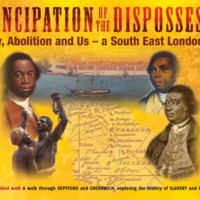
Emancipation of the Dispossessed: Slavery, Abolition and Us - a South East London angle
Emancipation of the Dispossessed was a local community project exploring the local history of Deptford and the surrounding areas and the connections with the transatlantic slave trade. Community groups and students from Lewisham College worked with theatre educators to research and develop 'Blood Sugar', a promenade performance through the Queen's House, Greenwich. The play, written and directed by John Turner, tells the story of slavery and abolition from a local angle, and the script was built around first-hand and eyewitness accounts, campaign pamphlets and reports to parliament. The project also produced learning resources aimed at Key Stage 3 History and Citizenship.
A guided walk explored Deptford’s links to the history of the transatlantic slave trade, uncovering stories of some of the local people who played an important role in the beginnings of the slave trade or the campaign for its abolition. London was an important slave trading port before Bristol and Liverpool dominated the trade. The trade and British colonies were protected by the Royal Navy, whose ships were built and prepared for voyages at the Royal Dockyards at Deptford.
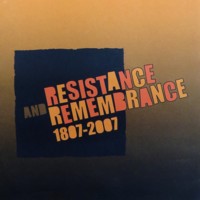
Resistance and Remembrance: Marking the 200th anniversary of the Parliamentary Abolition of the Transatlantic Slave Trade
Part of the British Museum's Atlantic Trade and Identity season, Resistance and Remembrance was a commemorative public day held at the British Museum on 25 March 2007, in association with the Royal African Society and Rendezvous of Victory. Placing a strong emphasis on resistance to the slave trade, the day included poetry readings, storytelling with Beyonder and H Patten, Bonnie Greer and Tony Sewell in discussion, and dramatised contemporary accounts of life as a slave. The day culminated in a Ceremony of Remembrance in the Museum's Great Court, featuring the telecast of a special message from Nelson Mandela.
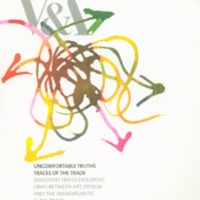
Uncomfortable Truths
Uncomfortable Truths at the Victoria and Albert Museum sought to expose how embedded the transatlantic slave trade was within British culture during the 18th and 19th centuries through art and design. A series of five trails - 'Traces of the Trade' - explored the permanent collections on display through the following themes: Consuming the Black Atlantic, Black Servants in British Homes, Britain and the West Indies, Representing Slavery and Abolitionism, Gold and Slaves Transnational Trade Links. An exhibition of contemporary art examined the impact of the legacies of slavery on modern art and design. The Victoria and Albert Museum commissioned new works by Yinka Shonibare, Romauld Hazoume, Julien Sinzogan and Keith Piper. These and other contemporary interventions by a total of 11 artists were displayed throughout the museum. This exhibition later toured to Ferens Art Gallery in Hull.
The 'Truth and Rights' season of events highlighted often untold stories of Black British heroes, including focus on the actor Ira Aldridge. Visitors were also offered discussions, debates, displays and an eight week free art course. A two-day conference, 'From Cane Field to Tea Cup: The Impact of the Transatlantic Slave Trade on Art and Design' focused on V&A collections took place in February 2007.
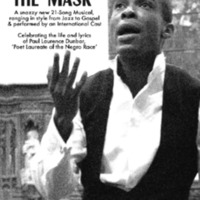
Lifting the Mask
London Shakespeare Workout presented a new 21-song musical, celebrating the life of the African-American poet Paul Laurence Dunbar. Dunbar's parents were freed slaves and he used some of their tales of plantation life in his work. Set backstage in a British theatre in 1897, the play explored themes such as love and loneliness, racial interactions, and the abolition of the slave trade. With an original score by Tim Williams, the play opened in Westcliffe, and toured 26 venues around the UK. Each performance was followed by a ‘talk-back’, allowing audience members to share their views on the issues raised by the production. Special interactive workshops were also created for schools and community groups to bring the concepts of slavery and abolition to life through history and literature.
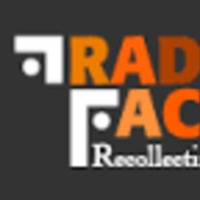
Trading Faces: Recollecting Slavery
Trading Faces: Recollecting Slavery was a consortium project developed by Future Histories (a non-profit organisation set up to maintain archives of African, Caribbean and Asian performing arts in the UK), Talawa Theatre Company (a leading Black-led touring theatre company) and V&A Theatre Collections. Trading Faces made use of archive documents, video and audio material to explore the legacy of the transatlantic slave trade in British performing arts and society. By promoting the use of primary resources, the online exhibition aimed to stimulate creativity, critical thinking, individual responsibility and participation. Highlights of the exhibition included a performance timeline featuring recently archived material from the past 200 years, narratives of slavery from both the past and present and a series of virtual rooms, which explored ritual, religion, carnival and masquerade amongst other aesthetic themes. On the Open Doors section of the site, users contributed material and ideas to promote a critical debate on the subject. As part of the project, the 'Retrace: Identity and Heritage' educational resource pack from Talawa Theatre Company is about the exchange of culture between the UK and other countries linked by the transatlantic slave trade and colonialism, and the impact of these relationships on the performing arts.
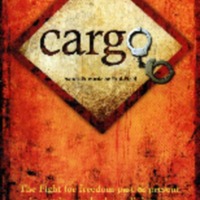
Cargo
Written by composer Paul Field, Cargo premiered in Hull City Hall in March 2007, sponsored by Hull City Council. Cargo featured contemporary songs, narration, dance and images that told the story of the struggles of slaves, the historical work of William Wilberforce and the abolition movement, through to the contemporary struggles against slavery today. Performers included the singer Coco Mbassi, saxophone player Mike Haughton and Springs Dance Company. The narrators and choir were local people, including members of City of Hull Youth Choir, Redemption Gospel Choir and Hot Gospel in Hull. Cargo was also performed in London, Plymouth, Bristol and Liverpool. Smaller events were put on by church and community groups around the UK, assisted by the script, score and backing track of the music being made available on CD-Rom.
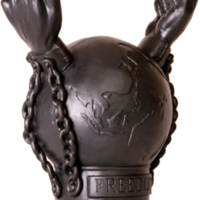
Abolition of the Slave Trade Act Commemorative Exhibitions
Nottingham Castle Museum held two exhibitions in 2007. Inspired by the anti-slavery medallion produced by Josiah Wedgwood in the 1790s, a group of young people from Nottingham’s African Caribbean community worked with artist Katherine Morling to explore issues surrounding slavery and the representation of black people in art. The group worked under the name Sankofa. The ceramic Globe of Freedom was fired at the Wedgwood factory in Staffordshire, and was displayed at Nottingham Castle Museum alongside the Wedgwood medallion. The word ‘FREEDOM’ is impressed on one side and ‘EQUALITY’ impressed on the other. A replica sculpture is still used as part of a handling collection loaned to schools and community groups in the Nottingham region. A second exhibition, in collaboration with the Open University in the East Midlands, looked at the British slave trade using slave narratives, telling the story of three survivors of slavery: Mary Prince, Robert Wedderburn and Quobna Ottobah Cugoano.
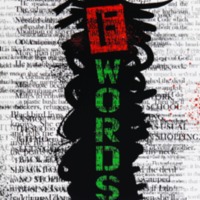
FWords
FWords was a creative response of eight Yorkshire writers and artists to the commemoration of the Abolition Act, in a project led by Peepal Tree Press in Leeds. Focusing on the many variations of the theme of 'Freedom', Fwords was created to raise the profile of Yorkshire's rich heritage of talented artists, descendants of those who migrated, forcefully and otherwise from Africa and beyond. The work of six writers was illustrated with work from two visual artists, and with a foreword from Caryl Phillips. The project was supported by printed materials, broadcasts, digital and dedicated web pages.
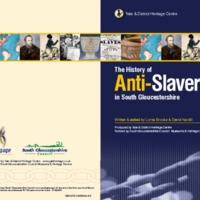
Impact: A history of anti-slavery in South Gloucestershire
This exhibition and booklet were produced as part of South Gloucestershire's Engage 2007 project, in partnership with Yate and District Heritage Centre. Both the exhibition and booklet explored local connections with the history of slavery and anti-slavery in South Gloucestershire. Links identified included the career of Robert Jenkinson of Hawkesbury (later Prime Minister Lord Liverpool), the Caribbean plantations of the Codrington family, the campaign efforts of abolitionist Joseph Sturge and, looking further back in history, St Wulfstan's attempts to abolish the trade in slaves to Ireland in the 11th century. The booklet was written and edited by Lorna Brooks and David Hardill. The exhibition toured the local area, including Thornbury and District Museum, pictured here.
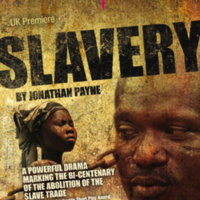
Slavery
A one-act play by Jonathan Payne, 'Slavery' re-tells the personal stories of enslaved Black Americans, using original recordings of interviews conducted by the United States Government's Federal Writers Project in the 1930s. The play brings together a collection of personal testimonials and spirituals (Christian songs created by African slaves in the United States), to explore the consequences of slavery. Presented in 2007 by the cross-cultural London theatre company Tara Arts and directed by Laura Kriefman, the play toured nationally during Black History Month. An Education Resource Pack was produced and drama workshops for schools were held after the performances to explore the issues raised.
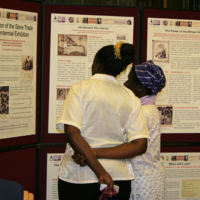
Abolition of the Slave Trade Bicentennial Exhibition
This exhibition held by the Cadbury Research Library: Special Collections at the University of Birmingham included material from the archives of the Church Missionary Society held there, and some of its rare book collections. The accompanying information boards are featured here. The exhibition focused on the role of religion in the abolitionist movement, the power of the African voice in literature, and the role played by Birmingham residents in the anti-slavery campaigns. A booklist on anti-slavery publications held at the library was also produced. The exhibition was part of a University-wide initiative, with additional involvement from academic departments and the Guild of Students. An online exhibition was also produced in collaboration with the Library of the Religious Society of Friends: 'Quakers and the path to abolition in Britain and the colonies'.
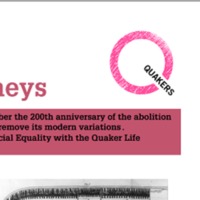
Quakers and the path to abolition in Britain and the colonies
The Society of Friends expressed its formal opposition to the slave trade in 1727, and from that date were vocal opponents of transatlantic slavery. A virtual exhibition of archived resources, ‘Quakers and the path to abolition in Britain and the colonies’, was launched online to commemorate the bicentenary. It traced the history of the anti-slavery movement from its Quaker beginnings and highlighted key events in the Quaker history of opposition to the slave trade, and was primarily based on material from the Library at Friends House. The exhibition also explained the important role played by Quaker women abolitionists through writing and poetry. The Quakers pioneered contemporary tactics such as boycotting, petitions, leafleting and poster campaigns.
Other resources to help people find out more about the bicentenary included ‘Abolition Journeys’, developed by Quaker Life Committee for Racial Equality with the Quaker Life Children and Young People’s Staff Team, designed to help people of all ages remember the slave trade and work to abolish its modern variations.
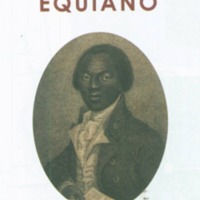
The Equiano Project
The Gas Hall at Birmingham Museum and Art Gallery was host to a biographical exhibition of the life and adventures of Olaudah Equiano, a leading African figure in the British abolition movement in the 18th century. The project was led by Birmingham Museum and Art Gallery and the Equiano Society. The national exhibition was inspired by Equiano's autobiography 'The Interesting Narrative' (1789), by international and national artworks, and objects from Birmingham museums’ collections. It provided a narrative of Equiano’s life, and also explored wider local links between the West Midlands and the transatlantic slave trade. The Equiano Project also created a website, educational packages (available to buy via the project website), and a series of events and outreach activities. The exhibition publication 'Equiano - Enslavement, Resistance and Abolition' was edited by Arthur Torrington, Rita McLean, Victoria Osborne and Ian Grosvenor, and provided new insights into enslavement, resistance, abolition, and the African presence in Britain in the 18th century. Two touring exhibitions were loaned to community centres, libraries and other venues, including Walsall Museum, Sheffield and District African Caribbean Community Association and the Hudawi Cultural Centre in Huddersfield.
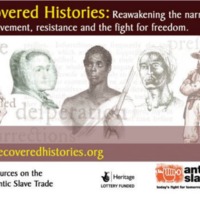
Recovered Histories
In the Recovered Histories online resource, Anti-Slavery International digitised and made accessible for the first time a collection of over 800 pamphlets dating from the 18th and 19th centuries relating to the transatlantic slave trade. The resource captured the narratives of the enslaved, the enslavers, slave ship surgeons, abolitionists, parliamentarians, clergy, planters and rebels. An accompanying touring historical exhibition and an education pack featured testimonies and pictures from Africans subjected to slavery, those participating in the enslavement and those who fought against it. An outreach and resources programme included a series of free regional seminars in April and May 2008, which encouraged dialogue about the transatlantic slave trade and its legacies by bringing together a wide range of groups and organisations who worked on these issues. The workshops were held in Bristol, Edinburgh, Leeds, London and Manchester. A series of short stories were published, inspired by the Recovered Histories resource.

Am I Not a Man and a Brother?
Am I Not a Man and a Brother? was a piece of documentary theatre devised by Reveal Theatre Company in partnership with North Staffordshire Racial Equality Council. It used stories and testimony from the African Caribbean community in Stoke-on-Trent and North Staffordshire, interwoven with historical and contemporary slave stories. The play was produced by Robert Marsden and Julia Barton. The production was launched at the Stoke-on-Trent Racial Equality Council - where it was performed to the local people who had contributed their stories and was accompanied by a performance by a local Black choir - and then toured to venues in Bristol, London and Liverpool.